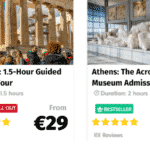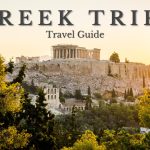Heraklion Archaeological Museum
Heraklion Archaeological Museum. It is one of the finest museums in Greece and the best in the world for Minoan art since it includes the most significant and comprehensive collection of relics of the Minoan civilization of Crete.
Book tickets for Heraklion Archaeological Museum online CLICK HERE GetYourGuide.com
The Heraklion Archaeological Museum started in 1883 as a small collection of artefacts.
A special structure was created from 1904 to 1912 at the suggestion of two Cretan archaeologists, Iosif Hatzidakis and Stefanos Xanthoudidis.
After three catastrophic earthquakes in 1926, 1930, and 1935, the museum almost collapsed.
The director of the Heraklion Museum was then Spyridon Marinatos, who made enormous efforts to collect finances and convince the inhabitants and the central government alike that a new strong structure was required.
In 1935, Marinatos succeeded in hiring Patroklos Karantinos to create a robust edifice that resisted both natural calamities and the bombardment that preceded the German invasion in 1941.
Although the museum was destroyed during World War II, the collection remained intact and again became available to the public in 1952. A new wing was erected in 1964.
The Herakleion Archaeological Museum is one of the biggest and most significant museums in Greece and among the most important museums in Europe.
It contains representative objects from all the eras of Cretan prehistory and history, encompassing a temporal range of about 5,500 years from the Neolithic period to Roman times.
The uniquely significant Minoan collection comprises rare specimens of Minoan art, many of them great masterpieces. The Heraklion Museum is justifiably acknowledged as the museum of Minoan civilization par excellence globally.
The Archaeological Museum is located in the town centre.
It was erected between 1937 and 1940 by architect Patroklos Karantinos on a location formerly inhabited by the Roman Catholic monastery of Saint-Francis which was devastated by an earthquake in 1856.
The museum’s antiseismic building is an excellent example of modernist design and was received a Bauhaus commendation.
Karantinos used the principles of contemporary architecture to the special demands of a museum by giving adequate lighting from the skylights above and along the top of the walls and permitting the smooth movement of big groups of people.
He also envisioned future expansions to the museum.
The color and building materials, such as the veined polychrome marbles, evoke some Minoan wall paintings which simulate marble revetment.
The two-storeyed structure features huge display rooms, labs, a drawing room, a library, offices and a unique section, the so-called Scientific Collection, where countless artifacts are preserved and examined.
The museum store, administered by the Archaeological Receipts Fund, offers museum reproductions, books, postcards and slides. There is also a café.
Most of the museum was closed for refurbishment in 2006 and reopened in May 2013.
The Heraklion Archaeological Museum is a Special Regional Service of the Ministry of Culture and its aim is to collect, protect, conserve, document, analyze, publish, exhibit and promote Cretan antiquities from the Prehistoric to the Late Roman eras.
The museum conducts temporary exhibits in Greece and abroad, interacts with scientific and intellectual institutes, and holds a variety of cultural events.
See also:
Highlights of the Lower Level
This museum showcases the predominance of the Minoans in the Aegean Sea. There are beautiful ceramics, such as pots and vases, made of clay. They come in many shapes and sizes. For example, from little vases to enormous pithoi. People use the typical Cretan large containers to store olive oil, wine, and grain in bulk.)
The labrys, a symmetrical double-bitted axe, is one of the first emblems of Greek culture. People have long connected it with feminine deities. Some are even taller than a human.
Researchers believe that people used the massive axes for rituals and sacrifices during religious rites.
Phaistos Disc
The Phaistos Disc, also known as Phaistos Disk or Phaestos Disc, dates back to the second millennium BC. It makes the Phaistos Palace on Crete’s island of Crete famous. A spiral of stamped symbols, measuring around 15 cm (5.9 in), covers both sides of the disk. We still do not know its purpose and where someone made it. Heraklion’s archaeological museum has put it on exhibit.
In 1908, archaeologist Luigi Pernier discovered the disc at the Phaistos palace site. The disc contains 241 tokens, each with a unique hieroglyphic “seal.” Pernier pressed these seals into a disk of soft clay in a clockwise spiral towards the center of the disk.
Both amateur and professional archaeologists have made many efforts to understand the signs on the Phaistos Disc. Decipherment efforts have focused on assuming that the script is a syllabary, alphabet, or logography, even if it isn’t obvious. To succeed in deciphering the signals, we must find more of them. Currently, we don’t have enough context to analyze them.
Minoan Jewelry
Jewellery from the Bronze Age Crete-based culture of the Minoan civilisation shows not only a strong technical understanding (in this instance, metals) and an ingenious design but also a love of vibrantly reflecting nature and a passion for flowing expressive shapes and patterns.
materials science and engineering
Egypt and the East inspired the Minoans. Especially by the Babylonians through Syria. This inspired them to develop their own distinct style in jewelry manufacturing. An advanced smelting process enabled Minoan jewellers to turn raw materials into a wide variety of items and patterns. They had a complete arsenal of methods. For example, craftsmen commonly manufactured rings using three-piece molds and the lost-wax process. However, they handcrafted the bulk of the items. In certain cases, beads might be mass-produced using this method.
They used metals like gold, silver, bronze, and gold-plated bronze to fabricate Minoan jewelry. They used stones such as garnet, lapis lazuli, obsidian, carnelian, and jasper of various colors. Imports of amethyst from Egypt show that the Minoans had a strong sense of their own identity when it came to materials and design. Furthermore, Minoan jewelers had access to materials such as faience and steatite (soapstone), ivory, shell, glass-paste, and Egyptian blue. It was a synthetic intermediary between the two.
As a result, gold was a rare and valuable product that was likely only available to individuals with a higher socioeconomic position. In certain instances, people used stamps to create the appearance of punching the material. The final technique in granulation attaches tiny gold spheres to the main piece of jewelry. Heating a mixture of glue and copper salt does this. The copper salt transforms into pure copper, thus soldering them together. Other techniques include dot repoussé, filigree (fine gold wire), inlaying and gold leaf covering.
The Snake Goddess
Enticing mysteries await.
Since its discovery by Sir Arthur Evans in a Crete tomb, the figure of the Snake Goddess has been widely replicated from antiquity. Regardless of whether or not this is true, she is an expressive and striking picture. Her significance to the Minoans who crafted her, on the other hand, is unknown.
Repositories” at Knossos, a “palace” complex, is where Evans discovered this sculpture of the Snake Goddess. He decided to dig beneath the paving stones after removing the western wing of the building and finding nothing. Two stone-lined pits just south of the Throne Room contained two pits containing a wide variety and broken precious things: scraps of gold and ivory, faience, stone inlay, unworked horn, ceramic vessels, seals stones, sealings and shells, vertebrae of large fish, and broken pieces of at least three figurine, which included the Snake Goddess.
Evans thought that the rich artefacts he had unearthed were the remnants of a temple that had been desecrated. “Temple Repositories” became his new term for the trenches, and he immediately started to re-creat as much as possible, with an emphasis on figurines of goddesses.
The hat and the cat
Originally unearthed, the Snake Goddess was missing a skull and part of her right arm. Evans saw a snake in the right arm’s short, wavy stripes, and so he interpreted it. Having snakes writhing up both of her arms was, in some part, to resemble the other almost full sculpture discovered in Temple Repositories. Halvor Bagge, a Danish artist, collaborated with Evans to restore the Snake Goddess. They made a matching arm and stripy snake, the head of the goddess, and the positioning of the hat and cat on her head (different faience pieces discovered in the Temple Repositories) on the figure.
The Snake Goddess is a young lady. She wears a long skirt with seven flounced layers of colorful material. She is 29.5 cm (11.5 inches) tall. This painting showcases Minoan flourishes. A variety of colored fabric bands create them. She wears an apron with diamond-shaped geometric patterns over the skirt. The patterns are on the front and back. She wraps the broad, striped band at the top of the skirt and an apron around her waist. She accessorizes with a low-cut, striped blouse. It reveals her huge, naked breasts on top. She knots it at the waist with an ornate knot. The snake goddess’s repaired head has a crown on top. Bagge and Evans felt it was suitable. Hair that falls down her back and reaches to the bottom of her cleavage is long and dark.
Is this a goddess?
The restoration and interpretation of the Snake Goddess is controversial. Because there is no Bronze Age lady shown with a crown and a cat, these items should be dismissed. Because there is no proof of the appearance of a Minoan goddess, it is impossible to identify this figure as a deity. This figure resembles several depictions of high-ranking Minoan ladies, maybe priestesses. If snake-wrangling is what makes her a deity, this is an issue as well. In the Temple Repositories, the depiction of a woman taming a snake or snakes is unique. It follows that she is not well-liked as a serpent goddess.
A goddess at Knossos, of course, was something of a goal for Evans. Before excavating the site, he had claimed that the pre-Classical Greeks worshipped a great mother goddess. Evans found—or created—what he was looking for in the Snake Goddess. The authenticity and significance of it, on the other hand, remain a matter of debate.
Collections
Room I
Covers findings from 6000 BCE to the pre-Palatial period, including:
- Neolithic fertility goddess
- Vasiliki ware
- stone jars from the island of Mochlos
- miniature clay sculptures
Room II
Covers findings from 2000 BCE to 1700 BCE in Knossos, Malia and several peak sanctuaries, including:
- Kamares ware pottery
- glazed plaques of Minoan houses (aka the “Town Mosaic”)
- peak sanctuary figurines
Room III
- Phaistos Disc
- Kamares ware pottery
Room IV
Covers findings from 1700 BCE to 1450 BCE, including:
- bull’s head rhyton from Knossos
- snake goddess figurines
- tools and weapons, mostly cast in bronze
- cups with Linear A inscriptions
Heraklion Archaeological Museum Room V
Covers findings from 1450 BCE to 1400 BCE, including:
- ancient Egyptian trade objects
- clay model of a house
- examples of Linear A and Linear B scripts
Heraklion Archaeological Museum Room VI
Covers findings from cemeteries at Knossos, Phaistos and Archanes, including:
- clay figurines
- gold jewellery
- horse burial from a tholos tomb at Archanes
Heraklion Archaeological Museum Room VII
Covers findings from 1700 BCE to 1300 BCE from smaller villas and sacred caves, including:
- bronze double axes
- the “Harvesters Vase”
- steatite vases from Hagia Triada
- gold jewelry from Malia
Heraklion Archaeological Museum Room VIII – Zakros
Covers findings from 1700 BCE to 1450 BCE from the palace of Zakros, including:
- rock crystal rhyton
- bull’s head rhyton
- pottery with floral and marine motifs
Room IX
Covers findings from 1700 BCE to 1450 BCE in eastern Crete, including:
- terracotta figurines from Pisokephalo peak sanctuary
- seal stones
Heraklion Archaeological Museum Room X – Mycenaean
Covers findings from 1400 BCE to 1100 BCE, including:
- clay figurines
- clay sculpture of dancers with a lyre player
Room XI – Dorian
Covers findings from 1100 BCE to 900 BCE during the arrival of the Dorian Greeks, including:
- weapons and tools, mostly of iron
- clay fertility figurines
- votive offerings
Room XII
Covers findings up to 650 BCE, including:
- pottery decorated with griffins
- artefacts and figurines from Kato Syme
Heraklion Archaeological Museum Room XIII – Larnakes
Minoan larnakes (clay coffins) are on display here.
Heraklion Archaeological Museum Room XIV – Hall of the Frescoes
- Frescoes from Knossos and Hagia Triada
- The Hagia Triada sarcophagus
Room XV & Room XVI
- More frescoes, including the famous “La Parisienne”
Room XX – Classical Greek, Greco-Roman
Sculptures from Classical Greek and Greco-Roman periods
General Information about the Archaeological Museum of Heraklion
Entrance: Full ticket, €10 Reduced ticket, €5.
Special ticket package: Full package, €16 Reduced package €8 (valid for 3 days. It includes the entrance to the Heraklion Archaeological Museum and the Palace of Knossos)
Heraklion Archaeological Museum: What hotels are nearby?Hotels nearby (Archaeological Museum of Heraklion)
The Heraklion Archaeological Museum, also known as the Heraklion Museum, the Crete Museum, Archaeological Museum Heraklion, archäologisches museum heraklion, Heraklion archaeological museum shop, Heraklion museum, Museum Heraklion, Heraklion museum, musee Heraklion, museo archeologico Heraklion, archaeological museum, or crete museum, showcases the rich history of Crete. This museum displays artifacts from the Minoan civilization, which flourished on the island of Crete over 4,000 years ago. Visitors can explore ancient pottery, jewelry, frescoes, and sculptures while learning about the Minoan culture and way of life.
See all hotels nearby (Heraklion Archaeological Museum)
What restaurants are nearby (Heraklion Archaeological Museum)?
Restaurants nearby (Heraklion Archaeological Museum):
- (0.06 χλμ) Haris Creperie – Heraklion
- (0.17 χλμ) ML Espresso Bar
- (0.13 χλμ) Crop Roastery Brewery
- (0.17 χλμ) Αντίποδας
- (0.13 χλμ) 626 All Day Lounge & City Garden
 Before you buy tickets, read the guide for 2024. Click Here
Before you buy tickets, read the guide for 2024. Click Here


